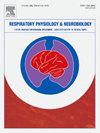Axonal projection of the medullary expiratory neurons in the feline thoracic spinal cord
Abstract
Expiratory neurons in the caudal ventral respiratory group extend descending axons to the lumbar and sacral spinal cord, and they possess axon collaterals, the distribution of which has been well-documented. Likewise, these expiratory neurons extend axons to the thoracic spinal cord and innervate thoracic expiratory motoneurons. These axons also give rise to collaterals, and their distribution may influence the strength of synaptic connectivity between the axons and the thoracic expiratory motoneurons. We investigated the distribution of axon collaterals in the thoracic spinal cord using a microstimulation technique. This study was performed on cats; one cat was used to make an anatomical atlas and six were used in the experiment. Extracellular spikes of expiratory neurons were recorded in artificially ventilated cats. The thoracic spinal gray matter was microstimulated from dorsal to ventral sites at 100-μm intervals using a glass-insulated tungsten microelectrode with a current of 150–250 μA. The stimulation tracks were made at 1 mm intervals along the spinal cord in segments Th9 to Th13, and the effective stimulating sites of antidromic activation in axon collaterals were systematically mapped. The effective stimulating sites in the contralateral thoracic spinal cord with expiratory neurons in the caudal ventral respiratory group (cVRG) occupied 14.4% of the total length of the thoracic spinal cord examined. The mean percentage of effective stimulating tracks per unit was 18.6 ± 4.4%. The distribution of axon collaterals of expiratory neurons in the feline thoracic spinal cord indeed resembled that reported in the upper lumbar spinal cord. We propose that a single medullary expiratory neuron exerts excitatory effects across multiple segments of the thoracic spinal cord via its collaterals.

 求助内容:
求助内容: 应助结果提醒方式:
应助结果提醒方式:


